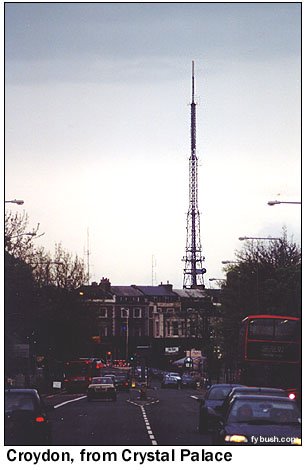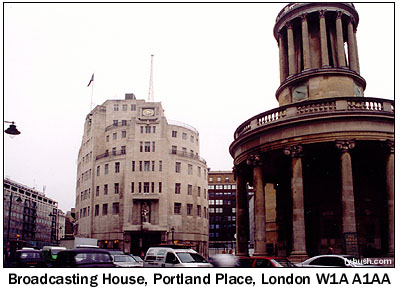
|
|
July 10-17, 2002
Crystal Palace and Croydon, England
Until now, all the sites we've presented here at Tower Site of the Week have had one important thing in common: they've all been on the same side of the Atlantic Ocean.
But in late April and early May of 2002, your editor had the opportunity to spend some time in England and France. And with the kind permission of Mrs. Editor, the vacation even included a few stops at interesting and important tower sites.

 This
week, we show you the very first tower we saw in England, on
a rainy Friday night in South London.
This
week, we show you the very first tower we saw in England, on
a rainy Friday night in South London.
"Crystal Palace" is a park in southeast London, a good 8 miles or so from the central parts of town, and a 45-minute ride on the number 3 bus from Piccadilly (through some parts of London not often frequented by tourists.)
This is one of the highest spots in London, which is why it was chosen by the BBC in the mid-fifties for the construction of a new TV tower to replace the old facility at Alexandra Palace.
"Ally Pally," in North London, was one of the oldest TV facilities in the world, having entered regular "high-definition" (405 lines!) service in 1936. Twenty years later, the BBC hoped to increase power and coverage of the southeast of England by building the 196-meter self-supporting tower at Crystal Palace to replace the shorter, lower-powered site at Alexandra Palace. (That location would re-enter use in the late nineties for a several lower-powered FMs, London Greek Radio on 103.3 and Choice on 107.1, as well as digital radio and low-powered UHF TV relays.)
When it signed on in 1956, Crystal Palace initially broadcast only the BBC television signal on channel 1, with the ITV (independent TV) signal on channel 9 emanating from another new tower nearby at the "Croydon" location in South Norwood. In the early sixties, the BBC began the move from 405-line VHF to 625-line UHF with the debut of BBC2 from Crystal Palace; eventually, as Britain moved completely to UHF, the ITV broadcasts, along with newcomer Channel 4 and BBC 1 and 2, all reached London viewers from Crystal Palace.
 FM
radio came to Crystal Palace in the eighties, as the BBC attempted
to fill in some reception problems from its main London FM site
at Wrotham, in Kent, some 25 miles southeast of London. The solution
the BBC engineers developed was to simulcast the Wrotham signals
precisely 304 kHz down the dial. BBC Radio Two, heard at 89.1
from Wrotham, is on 88.8 here; Radio Three (91.3 from Wrotham)
at 91.0 and Radio Four (93.5 from Wrotham) is on 93.2. Later,
Radio One transmitters were added at 98.8 in Wrotham and 98.5
at Crystal Palace.
FM
radio came to Crystal Palace in the eighties, as the BBC attempted
to fill in some reception problems from its main London FM site
at Wrotham, in Kent, some 25 miles southeast of London. The solution
the BBC engineers developed was to simulcast the Wrotham signals
precisely 304 kHz down the dial. BBC Radio Two, heard at 89.1
from Wrotham, is on 88.8 here; Radio Three (91.3 from Wrotham)
at 91.0 and Radio Four (93.5 from Wrotham) is on 93.2. Later,
Radio One transmitters were added at 98.8 in Wrotham and 98.5
at Crystal Palace.
Additional FM services here include BBC Radio London at 94.9; Classic FM (the national commercial network) at 100.6, complementing the 100.9 signal from Wrotham; and commercial xfm at 104.9.
More recently, the tower has seen the addition of digital radio and TV multiplexes, too, as well as the privatization that changed its ownership from the BBC to Crown Castle.
And wait - there's more! Look carefully at the side of the tower in the photo above and you'll see a longwire that runs off to the field below. It carries low-power (one kilowatt or less) transmissions from multilingual Spectrum Radio (558 kHz), a BBC Radio Four relay (720 kHz) and country station Ritz (1035 kHz).
So what's the nearby Croydon tower used for, since the sign-off of 405-line black and white TV in 1985? The new Channel 5 TV service, inaugurated in the mid-nineties, as well as a whole bunch of commercial stations: Capital Radio on 95.8, Choice on 96.9, ITN News Direct on 97.3, Kiss on 100.0, Jazz FM on 102.2, Magic on 105.4, Virgin Radio on 105.8 and Heart on 106.2. It can also be used for backup service for the BBC, ITV and Channel 4 television services in the event of an outage at Crystal Palace.
 One more treat will
finish off our look at British radio here on Site of the Week:
a view of Broadcasting House, the headquarters of the BBC's domestic
radio services in the upscale West End neighborhood north of
Oxford Circus.
One more treat will
finish off our look at British radio here on Site of the Week:
a view of Broadcasting House, the headquarters of the BBC's domestic
radio services in the upscale West End neighborhood north of
Oxford Circus.
The Art Deco building on the left side of the picture is the same one from which Ed Murrow made his famous wartime rooftop broadcasts as the bombs were falling; the sixties-era office blocks behind it are scheduled to be demolished within a few years to be replaced by a state-of-the-art facility that will be home to both domestic radio and the BBC World Service, now housed across town in Bush House.
Next week, we'll cross the Channel and show you a few nifty bits of French radio before returning to our home turf with some actual Northeastern transmitter sites.
(In the meantime, you can learn much more about Croydon, Crystal Palace and Alexandra Palace by visiting the appropriate pages on Mike Brown's awesomely comprehensive Transmitter Site Gallery. And set aside a couple of hours to read Arthur Dungate's amazing Direct Television from Alexandra Palace site for the firsthand story of how TV was broadcast from Ally Pally in the fifties!)
- Previous Site of the Week: Droitwich and Brookmans Park, England
- Next Week: the Eiffel Tower, Paris
- How can you help support Site of the Week? Click here!
- Submit your suggestions for a future Site of the Week!
